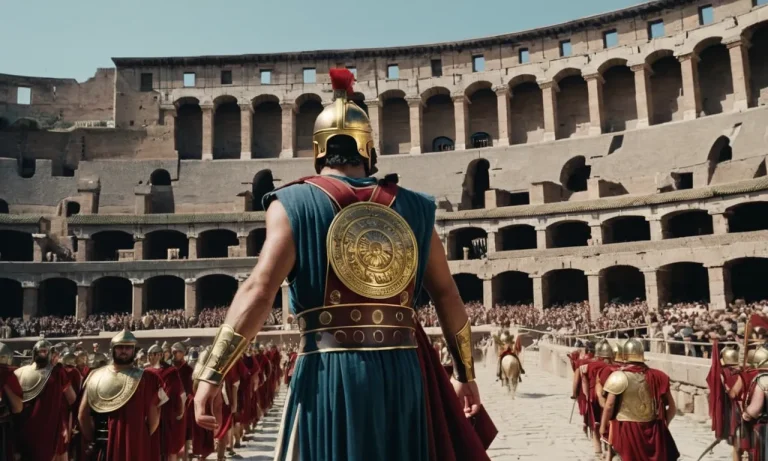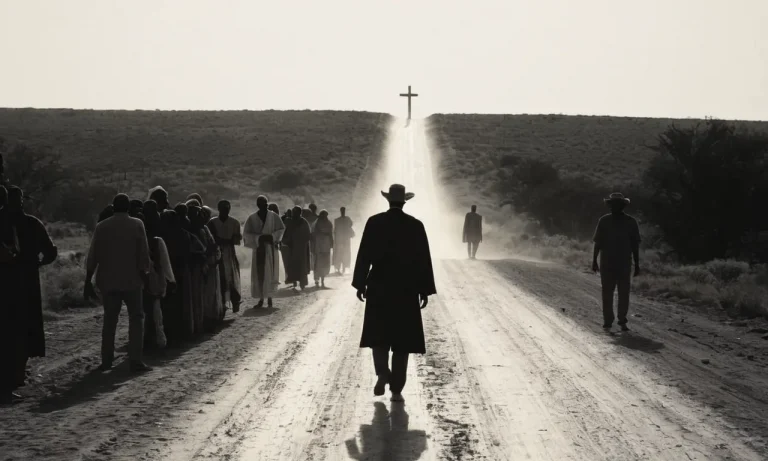What Did They Give Jesus To Drink On The Cross?
The crucifixion of Jesus Christ is one of the most well-known events in history. As he hung on the cross, the Bible tells us that Jesus was offered something to drink. But what exactly was this drink? If you’re short on time, here’s a quick answer: Jesus was given wine vinegar (sour wine) to drink while on the cross.
In this comprehensive article, we will examine the biblical accounts of the crucifixion to uncover what drink was offered to Jesus as he suffered and died. We will look at the significance of this drink, what it tells us about the nature of Jesus’ suffering, and how it fulfilled Old Testament prophecy.
The Gospel Accounts of What Jesus Was Given to Drink
Jesus Offered Wine Mixed with Gall
According to the Gospel of Matthew, when Jesus was on the cross, he was offered wine mixed with gall, also called wine mixed with myrrh. This was a medicinal drink sometimes given to condemned prisoners to dull the senses and relieve pain.
Matthew 27:34 states: “There they offered Jesus wine to drink, mixed with gall; but after tasting it, he refused to drink it.” This drink was likely given out of mercy to lessen Jesus’ suffering. However, Jesus refused it, choosing to remain fully conscious and suffer completely for our sins.
The Gospel of Mark also testifies that Jesus was offered wine mixed with myrrh but did not take it. Mark 15:23 says: “Then they offered him wine mixed with myrrh, but he did not take it.” Jesus consciously rejected any relief from his suffering in order to accomplish the Father’s will.
Jesus Offered Wine Vinegar While on the Cross
The Gospels record that while Jesus hung on the cross, he was given wine vinegar to drink. Wine vinegar was a cheap, sour wine used by Roman soldiers. This drink likely did not have any pain-relieving properties.
The Gospel of Matthew recounts: “Immediately one of them ran and got a sponge. He filled it with wine vinegar, put it on a staff, and offered it to Jesus to drink” (Matthew 27:48). Mark also testifies: “Someone ran, filled a sponge with wine vinegar, put it on a staff, and offered it to Jesus to drink” (Mark 15:36).
John’s Gospel provides additional details, noting that Jesus said “I thirst” before he was given the wine vinegar: “Later, knowing that everything had now been finished, and so that Scripture would be fulfilled, Jesus said, ‘I am thirsty.’
A jar of wine vinegar was there, so they soaked a sponge in it, put the sponge on a stalk of the hyssop plant, and lifted it to Jesus’ lips. When he had received the drink, Jesus said, ‘It is finished'” (John 19:28-30).
Rather than a pain reliever, this cheap wine vinegar may have been intended to prolong Jesus’ life on the cross. But instead of refusing it as he had the wine mixed with myrrh, Jesus accepted this drink as part of God’s plan.
After tasting the wine vinegar, Jesus declared his work was finished, then gave up his spirit.
The Significance and Symbolism of the Drink Offered to Jesus
A Painkilling Potion to Ease Suffering
There are conflicting accounts about what Jesus was given to drink while on the cross. Some argue it was a pain-relieving potion or tonic intended to slightly dull or alleviate the excruciating agony of crucifixion (bibleinfo.com).
Historical records describe this as a vinegar-based drink mixed with crushed flowers and herbs like hyssop or gall, although the exact ingredients remain uncertain.
This act could have been one of mercy, offered by sympathetic spectators or soldiers to reduce Jesus’ intense suffering. Or it may have simply been standard practice on the part of Romans to provide some pain relief during lengthy public crucifixions.
An Act of Mockery and Contempt
However, some biblical accounts frame the drink as one final insult, where onlookers mockingly offered Jesus the cheap wine that common Roman soldiers drank instead of water (John 19:28-30). This vinegar wine would have quenched Jesus’ thirst as he agonized on the cross for hours, but the means of offering it seems clearly contemptuous.
So the drink could symbolize the crowd’s continued scorn and rejection of Jesus’ claims of authority and divinity, serving as a bitter draught of humiliation to accompany his painful, humiliating public execution.
Fulfilling Psalm Prophecy
Some theologians argue there is deeper theological symbolism here. Jesus was fulfilling the cry of anguish and abandonment expressed in Psalm 69, which states “for my thirst they gave me vinegar to drink” (Psalm 69:21).
So his final thirst represented a self-sacrificing act to serve God’s redemptive plan.
Therefore, for Christians, being “quenched” by sour wine foreshadows the sweet salvation Christ earns for believers through his Passion. It connects Christ to righteous Old Testament sufferers like Job who endured bitterness and sorrow for higher purposes.
The Nature of Jesus’ Physical Suffering on the Cross
The Excruciating Pain of Crucifixion
Crucifixion was one of the most painful and brutal execution methods in ancient times. Jesus endured tremendous physical agony during his 6 hours on the cross, including massive blood loss, hypovolaemic shock, and muscle cramps from being in a twisted position for a prolonged time (source).
The pain was so intense that the word “excruciating” literally means “out of crucifying”.
Specifically, Jesus’ palms and feet were pierced with large iron nails to fix him to the wooden cross. This caused severe nerve and tissue damage, resulting in traumatic shock. Hanging by his arms also pulled Jesus’ joints from their sockets, causing great pain.
To breathe, Jesus had to push up on his nailed feet to inhale – an extremely agonizing movement that he did repeatedly for hours.
In addition, Jesus wore a crown of long thorns that cut his head, causing blood loss, pain, and temporary blindness from the blood running into his eyes. Such immense physical trauma triggered multiple physiological responses, including rapid heartbeat, fever, infection, and fluid built up around his heart and in his lungs (source).
His body went into crisis mode due to extreme stress.
Jesus’ Offer of Drink Part of His Rejection of Earthly Comfort
While on the cross, Jesus refused wine mixed with myrrh – a mild analgesic that was commonly given to crucifixion victims to relieve some of their suffering (source). This demonstrated Jesus’ commitment to fully experiencing the agony of crucifixion, out of obedience to God’s redemptive plan.
Some scholars believe the drink offered to Jesus before his death was also wine vinegar. This cheap wine would have intensified Jesus’ thirst without providing relief (source). By rejecting it, Jesus refused any earthly attempt to minimize his physical torment in his final moments.
Both acts showed Jesus resolutely enduring intense anguish to complete his atoning sacrifice on behalf of humanity. Though he was the Son of God, Jesus did not want the pain of his cruel death alleviated.
Instead, he looked past the cross to the joy of bringing salvation to those who would believe in him (source).
Alternative Theories and Claims About Jesus’ Drink
The Vinegar Sponge – Hyssop or Reed?
The synoptic gospels state that right before Jesus died, someone lifted a sponge soaked in sour wine (or vinegar) to His mouth on a stick of hyssop (John 19:29). Hyssop is a herb used to sprinkle blood during rituals.
But some skeptics question whether hyssop could reach Jesus’ mouth when He was crucified on a high cross. Was it actually a reed that was used instead of hyssop? Let’s analyze the evidence.
According to biblical scholar Stefanovich, the plant identified as hyssop in the Bible may actually be Syrian oregano which has lengthy branches that could reach a crucifixion victim. So there is no contradiction here.
Ancient Greek has a wide semantic range for “hyssop” that includes other plants beyond hyssop officinalis. The sponge may have indeed been lifted on hyssop, not just a tall reed.
Myrrh as an Alternative Possibility
A fringe theory proposes that Jesus was given a myrrh cocktail instead of sour wine on the cross. Myrrh is known for its medicinal sedative effects. Could Jesus have been drugged? One proponent is writer Mark D. Roberts who speculates the drink could have been a pain-relieving myrrh-wine mixture that Jesus refused to numb his suffering.
While an interesting idea, most evidence points to sour wine or vinegar. Beyond the gospel accounts, historical records confirm vinegar was commonly given to victims to prolong life (source). Myrrh’s expense also makes it unlikely to have been used for executions.
Still, we may never fully know the drink’s exact composition.
Conclusion
As we have seen, the drink offered to Jesus as he bore the pain and humiliation of the cross held great symbolic meaning. The wine vinegar epitomized the mockery and contempt Jesus faced, even as he willingly endured immense suffering for our salvation.
Examining the details around this single action – offering Jesus a drink – gives us a window into the unmatched love shown through Christ’s sacrifice.








